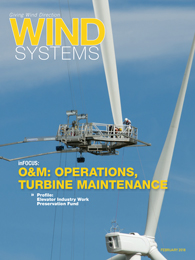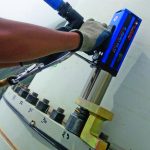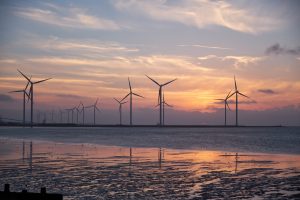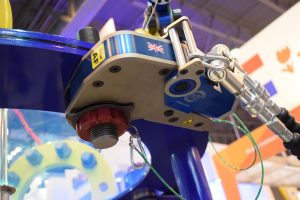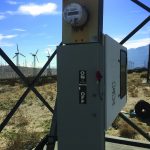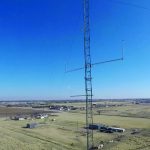Wind-farm operators in cold-weather climates such as Canada, Sweden, and parts of the United States are confronted with unique operating challenges. When faced with extreme temperatures of -20 degrees Celsius or lower, atmospheric icing becomes the leading cause of a variety of challenges. And in cold-weather climates, where icing is a frequent occurrence for up to six months of the year, wind-energy projects are often viewed as less feasible or less successful.
The most common challenges created by ice accretion are: reduced production power, reduced lifespan of equipment, and public safety concerns. In its recent study, Development and Validation of an Ice Prediction Model for Wind Farms (2016), the TechnoCentre Eolien summarized: “During an icing event, the presence of ice on turbine blades alters their aerodynamic properties, which reduces their efficiency and generates vibrations. The latter magnify the material fatigue of turbine components, which ultimately compromises their service life. Furthermore, turbines must occasionally be shut down to prevent the risk of ice throw, which can cause injuries to wind-farm employees or citizens residing in proximity.”
Fortunately, a variety of technologies are mitigating these common challenges, and leveling the playing field between cold- and warm-weather climate operators.
Challenge No. 1: Reduced Production Power
At any given time, a change in vibrational and/or torsional force on the turbine blade can result in a loss of production power. In cold weather, where ice buildup is frequent, changes in torsional force are commonplace. Many systems exist to detect such changes and would traditionally trigger an automated shut-down cycle. Such a cycle lasts for a period of time, which lengthens each time the turbine attempts to restart, detects a continued change in torsional force, and triggers the next shut-down cycle.

While this shutdown mechanism is beneficial in reducing unnecessary wear on the equipment, it’s hugely detrimental to power production. In cold weather climates, ice build up can sometimes last for days, during which time the shutdown cycle has continued to increase to the point where, when the ice finally melts, the turbine may not be triggered to start up again for several hours. This results in significant losses in power production.
According to a six-year CanmetENERGY Ottawa (CEO) study, the average loss factor of wind-energy production in cold weather climates is 3.9 percent. This translates to an estimated total loss of 959 GWh per year across Canada, representing $113 million in lost revenues country wide (Natural Resources Canada, 2017).
Challenge No. 2: Reduced Lifespan of Equipment
In cold climates, operation and maintenance requirements are far more demanding than in warmer temperatures. IEA Wind’s recent publication, Wind Energy Projects in Cold Climates, affirms the economic risk of “increased maintenance costs due to low temperatures and the likely higher-than-average downtime between repairs caused by turbine inaccessibility” (2017).
Ice greatly affects the longevity of turbine blades, nacelles, and motors. As we know, ice build up will create an imbalance in the forces acting on the turbine. Depending on the blade orientation, if one blade has accumulated ice, it can begin pulling outwards, putting additional strain on the gearbox. In addition, icefall has the potential to affect surrounding blades, as well as the roof of the hub, causing significant damage.
Performing maintenance on wind turbines is an additional challenge due to potential inaccessibility. Heavy snowfall can make accessing wind-farm roadways impossible with regular service vehicles. Implementing a regular snow removal schedule during winter months, and/or investing in specialized equipment, will eliminate accessibility issues; however, both options require significant capital expenses.
Challenge No. 3: Safety Concerns
Ice throw from turbine blades is a significant concern for public safety. A turbine with an 80-meter blade diameter and 70-meter hub height has the potential to throw a piece of ice a distance of 225 meters. And as the number and height of installed turbines increases in and around urban areas, public safety becomes increasingly important. In well-established markets like Germany, where the density of wind turbines is much higher than that of North America, it has been mandated that ice detectors be present on all turbines. As the North American market gets denser, it may be subject to similar future mandates.
Operator safety is another serious concern. Ice throw and ice shedding (where fragments of ice and snow fall from the blade) are a risk for anyone working in close proximity to turbines.

Best Practices
In February 2017, IEA Wind published a study of recommended best practices for wind-energy projects in cold climates. Within the study, it specifically outlined a variety of components and technologies aimed at mitigating the specific challenges outlined above. In particular, the following components and technologies were addressed:
Materials and components: Adapted for low-temperature applications such as low temperature alloys and special elastomers instead of standard rubber.
Welding procedures: Should all be completed with special low-temperature flux.
Lubricants: (Grease and oils) and hydraulic fluids suitable for low temperature.
Heaters: For components and lubricants, e.g. for generator, gearbox, yaw-and-pitch systems, control boxes, converters, and transformers.
- Blade heaters are an option that work to eliminate ice buildup altogether by forcing hot air directly into the blades. While highly effective in reducing ice formation, they are an expensive option and require a power source to run, which doesn’t help to reduce power production.
- Nacelle heating to allow a reasonably safe and comfortable working environment for turbine maintenance.
Cooling system: Suitable for low-temperature operation to avoid icing of condensers or other systems.
Control system: Designed with low-temperature features, such as preheating of components and subsystems during cold start after a grid failure.
Measurement systems: Including heated sensors. It’s recommended that the measurement system support structures, such as mounting booms, are also heated.
Ice detection systems: To safeguard nearby personnel and infrastructure from ice throw and to safeguard the wind turbine against rotor unbalances and potential damage to the turbine. Ice detectors are one of the least expensive, low-maintenance, and long-lasting solutions available today. Once attached to the hub or a nearby meteorological tower, they work to detect ice accumulation via an ultrasonic axially vibrating tube that senses changes in mass as a result of ice accretion. They act as an early detection system, allowing operators to shut down turbines immediately and then restart them once the ice has melted, significantly reducing operational downtime.
Blade ice protection technology: To prevent down time, mitigate ice-throw risks, decreased iced-blade noise emissions, and reduce potential increased turbine loading due to icing. Ice-phobic coatings are another potential solution: A coating or spray is applied directly to the blades, which discourages the accumulation of ice. The lower initial cost of application makes these coatings an effective solution, though ongoing maintenance and continued applications are required.
Cameras: An effective complementary tool for improving safety around wind farms. Outdoor cameras built to withstand harsh climates are installed on the hub of the turbine, where they provide visual confirmation that corroborates data from other prevention methods.
The extreme temperatures of cold-weather climates present many challenges to wind-farm operators. Continued collaboration between manufacturers and energy producers will promote new and innovative solutions. These will work to shape the wind-energy landscape, increase the viability of North American cold-climate wind-energy markets, and create opportunities for operators to become leaders in renewable energy.
















